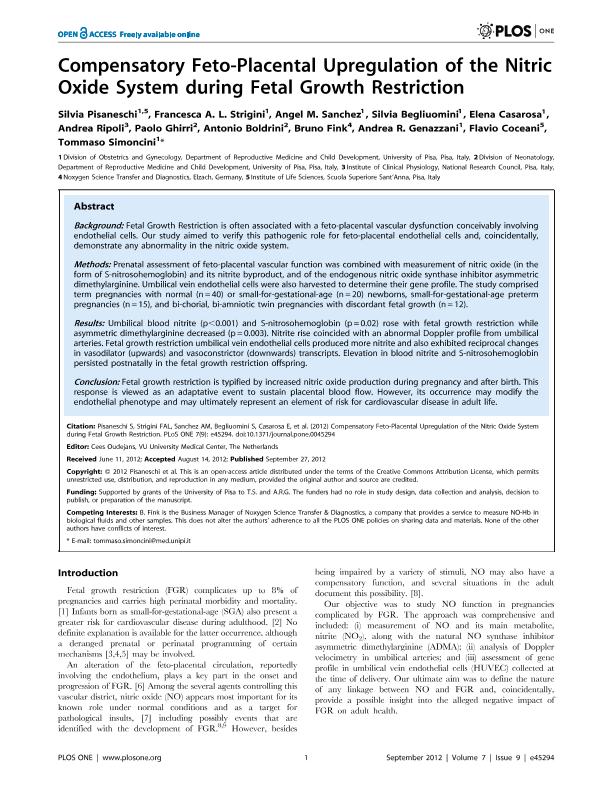Artículo
Compensatory Feto-Placental Upregulation of the Nitric Oxide System during Fetal Growth Restriction
Pisaneschi, Silvia; Strigini, Francesca A. L.; Sanchez, Angel Matias ; Begliuomini, Silvia; Casarosa, Elena; Ripoli, Andrea; Ghirri, Paolo; Boldrini, Antonio; Fink, Bruno; Genazzani, Andrea R.; Coceani, Flavio; Simoncini, Tommaso
; Begliuomini, Silvia; Casarosa, Elena; Ripoli, Andrea; Ghirri, Paolo; Boldrini, Antonio; Fink, Bruno; Genazzani, Andrea R.; Coceani, Flavio; Simoncini, Tommaso
 ; Begliuomini, Silvia; Casarosa, Elena; Ripoli, Andrea; Ghirri, Paolo; Boldrini, Antonio; Fink, Bruno; Genazzani, Andrea R.; Coceani, Flavio; Simoncini, Tommaso
; Begliuomini, Silvia; Casarosa, Elena; Ripoli, Andrea; Ghirri, Paolo; Boldrini, Antonio; Fink, Bruno; Genazzani, Andrea R.; Coceani, Flavio; Simoncini, Tommaso
Fecha de publicación:
09/2012
Editorial:
Public Library of Science
Revista:
Plos One
ISSN:
1932-6203
Idioma:
Inglés
Tipo de recurso:
Artículo publicado
Clasificación temática:
Resumen
Background: Fetal Growth Restriction is often associated with a feto-placental vascular dysfunction conceivably involving endothelial cells. Our study aimed to verify this pathogenic role for feto-placental endothelial cells and, coincidentally, demonstrate any abnormality in the nitric oxide system. Methods: Prenatal assessment of feto-placental vascular function was combined with measurement of nitric oxide (in the form of S-nitrosohemoglobin) and its nitrite byproduct, and of the endogenous nitric oxide synthase inhibitor asymmetric dimethylarginine. Umbilical vein endothelial cells were also harvested to determine their gene profile. The study comprised term pregnancies with normal (n = 40) or small-for-gestational-age (n = 20) newborns, small-for-gestational-age preterm pregnancies (n = 15), and bi-chorial, bi-amniotic twin pregnancies with discordant fetal growth (n = 12). Results: Umbilical blood nitrite (p<0.001) and S-nitrosohemoglobin (p = 0.02) rose with fetal growth restriction while asymmetric dimethylarginine decreased (p = 0.003). Nitrite rise coincided with an abnormal Doppler profile from umbilical arteries. Fetal growth restriction umbilical vein endothelial cells produced more nitrite and also exhibited reciprocal changes in vasodilator (upwards) and vasoconstrictor (downwards) transcripts. Elevation in blood nitrite and S-nitrosohemoglobin persisted postnatally in the fetal growth restriction offspring. Conclusion: Fetal growth restriction is typified by increased nitric oxide production during pregnancy and after birth. This response is viewed as an adaptative event to sustain placental blood flow. However, its occurrence may modify the endothelial phenotype and may ultimately represent an element of risk for cardiovascular disease in adult life.
Archivos asociados
Licencia
Identificadores
Colecciones
Articulos(IMBECU)
Articulos de INST. DE MEDICINA Y BIO. EXP. DE CUYO
Articulos de INST. DE MEDICINA Y BIO. EXP. DE CUYO
Citación
Pisaneschi, Silvia; Strigini, Francesca A. L.; Sanchez, Angel Matias; Begliuomini, Silvia; Casarosa, Elena; et al.; Compensatory Feto-Placental Upregulation of the Nitric Oxide System during Fetal Growth Restriction; Public Library of Science; Plos One; 7; 9; 9-2012; 1-9; e45294
Compartir
Altmétricas



